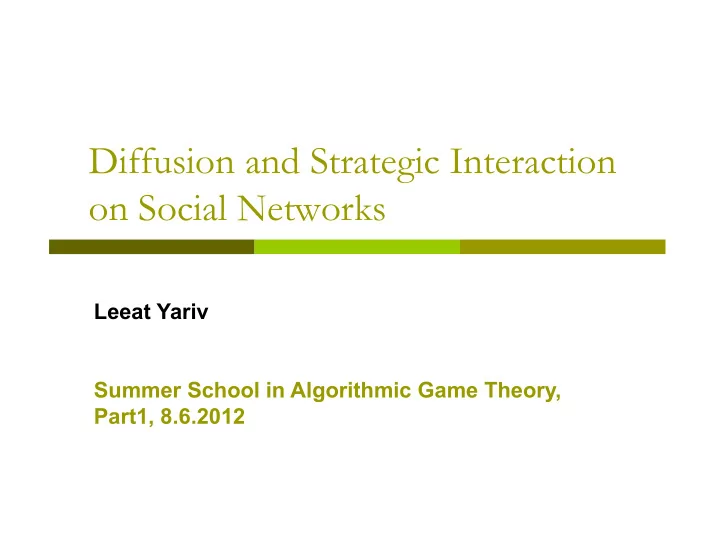

Questions: How do choices to invest in education, learn a language, etc., depend on social network structure and location within a network? How does network structure impact behavior and welfare? Complexity of calculating equilibria? How does relative location in a network impact behavior and welfare? How does behavior propagate through network (important for marketing, epidemiology, etc.)?
Questions: How do choices to invest in education, learn a language, etc., depend on social network structure and location within a network? How does network structure impact behavior and welfare? Complexity of calculating equilibria? How does relative location in a network impact behavior and welfare? How does behavior propagate through network (important for marketing, epidemiology, etc.)?
Example - Experimentation Suppose you gain 1 if anyone experiments, 0 otherwise, but experimentation is costly (grains, software, etc.)
Example - Experimentation Suppose you gain 1 if anyone experiments, 0 otherwise, but experimentation is costly (grains, software, etc.) EXPERIMENTATION – 1 NO EXPERIMENTATION - 0 Knowing the network structure – multiple stable states: 1 1 1 0 1 1
Example - Experimentation Suppose you gain 1 if anyone experiments, 0 otherwise, but experimentation is costly (grains, software, etc.) EXPERIMENTATION – 1 NO EXPERIMENTATION - 0 Knowing the network structure – multiple stable states: 0 1 0 1 0 1 1 0 0 0 1 1
Example – Experimentation (2) Not knowing the structure
Example – Experimentation (2) Not knowing the structure Probability p of a link between any two agents (Poisson..).
Example – Experimentation (2) Not knowing the structure Probability p of a link between any two agents. Symmetry
Example – Experimentation (2) Not knowing the structure Probability p of a link between any two agents. Symmetry Probability that a neighbor experiments independent of own degree (number of neighbors) → Higher degree less willing to choose 1 → Threshold equilibrium: low degrees experiment, high degrees do not.
Example – Experimentation (2) Not knowing the structure Probability p of a link between any two agents. Symmetry Probability that a neighbor experiments independent of own degree (number of neighbors) → Higher degree less willing to choose 1 → Threshold equilibrium: low degrees experiment, high degrees do not. Strong dependence on p p=0 → all choose 1, p=1 → only one chooses 1.
General Messages Information Matters
General Messages Information Matters Location Matters Monotonicity with respect to degrees Regarding behavior (complementarities…) Regarding expected benefits (externalities…)
General Messages Information Matters Location Matters Monotonicity with respect to degrees Regarding behavior (complementarities…) Regarding expected benefits (externalities…) Network Structure Matters Adding links affects behavior monotonically (complementarities…) Increasing heterogeneity has regular impacts.
Challenge Complexity of networks Tractable way to study behavior outside of simple (regular structures)?
Focus on key characteristics: Degree Distribution Degree of node = number of neighbors How connected is the network? average degree, FOSD shifts. How are links distributed across agents? variance, skewness, etc.
What we analyze: A network describes who neighbors are, whose actions a player cares about: 0 0 0 1 1 0 1 1 1 0 1
What we analyze: A network describes who neighbors are, whose actions a player cares about: 0 0 0 1 1 0 1 1 1 0 1 Players choose actions (today: in {0,1})
What we analyze: A network describes who neighbors are, whose actions a player cares about: 0 0 0 1 1 0 1 1 1 0 1 Players choose actions (today: in {0,1}) Examine equilibria how play diffuses through the network
Games on Networks g is network (in {0,1} nxn ): 1 i j connected g ij 0 otherwise
Games on Networks g is network (in {0,1} nxn ): 1 i j connected g ij 0 otherwise N i (g) i’s neighborhood, N ( g ) { j g 1 } i ij
Games on Networks g is network (in {0,1} nxn ): 1 i j connected g ij 0 otherwise N i (g) i’s neighborhood, N ( g ) { j g 1 } i ij d i (g)=|N i (g)| i’s degree
Games on Networks g is network (in {0,1} nxn ): 1 i j connected g ij 0 otherwise N i (g) i’s neighborhood, N ( g ) { j g 1 } i ij d i (g)=|N i (g)| i’s degree Each player chooses an action in {0,1}
Payoff Structure: (today) Complements Payoffs depend only on the number of neighbors choosing 0 or 1.
Payoff Structure: (today) Complements Payoffs depend only on the number of neighbors choosing 0 or 1. normalize payoff of all neighbors choosing 0 to 0
Payoff Structure: (today) Complements Payoffs depend only on the number of neighbors choosing 0 or 1. normalize payoff of all neighbors choosing 0 to 0 v(d,x) – c i payoff from choosing 1 if degree is d and a fraction x of neighbors choose 1 Increasing in x
Payoff Structure: (today) Complements Payoffs depend only on the number of neighbors choosing 0 or 1. normalize payoff of all neighbors choosing 0 to 0 v(d,x) – c i payoff from choosing 1 if degree is d and a fraction x of neighbors choose 1 Increasing in x c i distributed according to H
Examples (payoff: v(d,x)-c) Average Action : v(d,x)=v(d)x= x (classic coordination games, choice of technology) Total Number : v(d,x)=v(d)x=dx (learn a new language, need partners to use new good or technology, need to hear about it to learn) Critical Mass : v(d,x)=0 for x up to some M/d and v(d,x)=1 above M/d (uprising, voting, …) Decreasing : v(d,x) declining in d (information aggregation, lower degree correlated with leaning towards adoption)
Information (covered networks, payoffs) Incomplete information know only own degree and assume others’ types are governed by degree distribution presume no correlation in degree Bayesian equilibrium – as function of degree
Recommend
More recommend